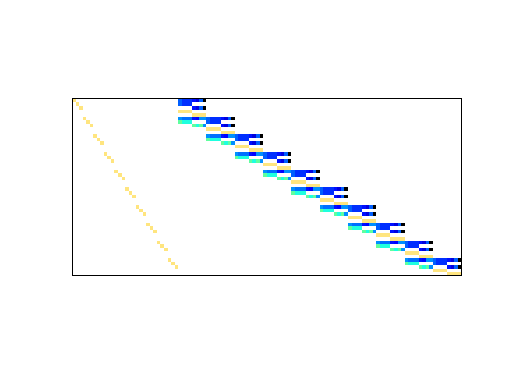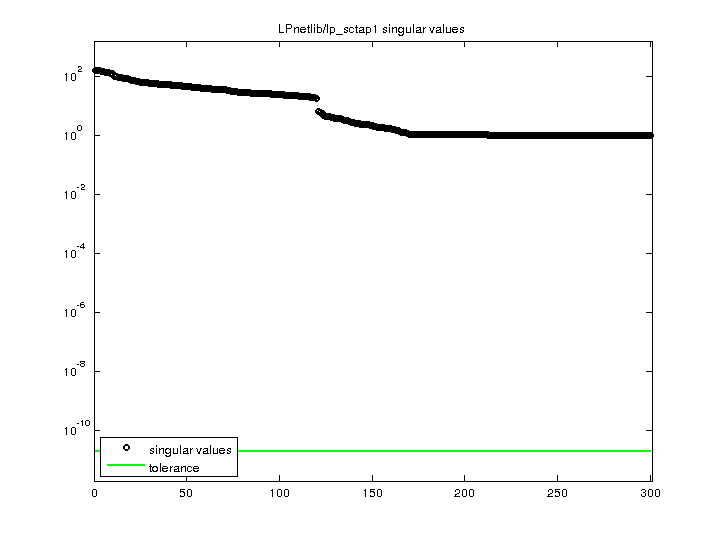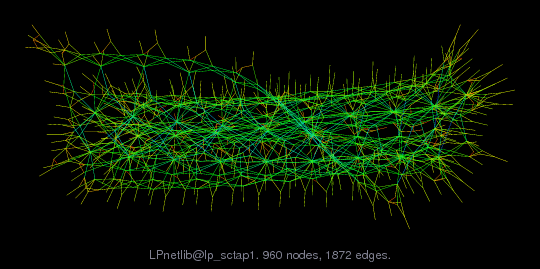LPnetlib/lp_sctap1
Netlib LP problem sctap1: minimize c'*x, where Ax=b, lo<=x<=hi
| Name |
lp_sctap1 |
| Group |
LPnetlib |
| Matrix ID |
678 |
|
Num Rows
|
300 |
|
Num Cols
|
660 |
|
Nonzeros
|
1,872 |
|
Pattern Entries
|
1,872 |
|
Kind
|
Linear Programming Problem |
|
Symmetric
|
No |
|
Date
|
1981 |
|
Author
|
J. Ho, E. Loute |
|
Editor
|
R. Fourer |
| Structural Rank |
300 |
| Structural Rank Full |
true |
|
Num Dmperm Blocks
|
1 |
|
Strongly Connect Components
|
1 |
|
Num Explicit Zeros
|
0 |
|
Pattern Symmetry
|
0% |
|
Numeric Symmetry
|
0% |
|
Cholesky Candidate
|
no |
|
Positive Definite
|
no |
|
Type
|
integer |
| SVD Statistics |
| Matrix Norm |
1.655931e+02 |
| Minimum Singular Value |
1.000000e+00 |
| Condition Number |
1.655931e+02
|
| Rank |
300 |
| sprank(A)-rank(A) |
0 |
| Null Space Dimension |
0 |
| Full Numerical Rank? |
yes |
| Download Singular Values |
MATLAB
|
| Download |
MATLAB
Rutherford Boeing
Matrix Market
|
| Notes |
A Netlib LP problem, in lp/data. For more information
send email to netlib@ornl.gov with the message:
send index from lp
send readme from lp/data
The following are relevant excerpts from lp/data/readme (by David M. Gay):
The column and nonzero counts in the PROBLEM SUMMARY TABLE below exclude
slack and surplus columns and the right-hand side vector, but include
the cost row. We have omitted other free rows and all but the first
right-hand side vector, as noted below. The byte count is for the
MPS compressed file; it includes a newline character at the end of each
line. These files start with a blank initial line intended to prevent
mail programs from discarding any of the data. The BR column indicates
whether a problem has bounds or ranges: B stands for "has bounds", R
for "has ranges".
The optimal value is from MINOS version 5.3 (of Sept. 1988)
running on a VAX with default options.
PROBLEM SUMMARY TABLE
Name Rows Cols Nonzeros Bytes BR Optimal Value
SCTAP1 301 480 2052 14970 1.4122500000E+03
Supplied by Bob Fourer.
When included in Netlib: Extra free rows omitted.
Source: J.K. Ho and E. Loute, "A Set of Staircase Linear Programming
Test Problems", Math. Prog. 20 (1981), pp. 245-250.
|


